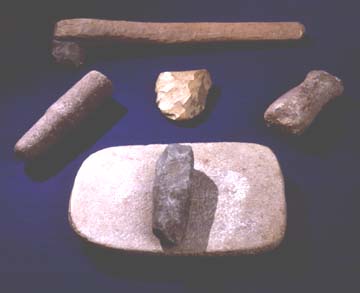

| |
|
|
|
|
|
||
| |
 |
|
|
||||
| |
|
|
|||||
| |
|
|
|||||
| |
|
|
|
|
|
||
| |
|||||||
| From the Paleolithic to Genghis Khan | |||
| Archaeologists have found
evidence for human occupation of Mongolia starting in the Lower Paleolithic
(perhaps 500,000 years ago). *
The area has shown evidence
of human occupation ever since.
Before Genghis Khan, the Mongolian nomads followed a typical pattern of nomadic peoples, alternating between vast empires and small-scale tribal organization. The first empire was built by the Hunnu, a proto-Mongolian tribe. The Hunnu Empire (3rd century BCE-1st century CE) played a major role in shaping the social and political structures of Central Asian nomadic tribes. |
 |
||
| Neolithic tools, from the collection of the National Museum of Mongolian History. | |||
| The Hunnu established a strong military-administrative structure, hereditary rule, and the division of the army and the population into units of tens, hundreds, and thousands. They conquered various neighboring nomadic tribes, and at the zenith of their power they held a vast territory stretching from Turkestan to Mongolia and Siberia. * | |||
| In 93 CE the Xianbei, an ancient Mongolian nomadic tribe, defeated the Hunnu, replacing the empire with its own leadership. Several states followed in succession: Toba, Jujan, Altai Turk, Uighur, Kirgiz, Khitan, and Jurchid.* By 1162, the year of Genghis Khan's birth, the Mongolian tribes had fought so many futile battles against external enemies that the economy collapsed and the population sank into poverty, fear, and uncertainty. | |||
|
The ancestors of present-day Mongolians lived around the rivers Onon, Herlen, Tuul, and Orhon in felt tents, or gers; they were nomads and hunters much like modern Mongolian nomads, seasonally moving from one place to another to find better pastures. They drank airag or fermented mare's milk, and ate animal meat, dairy products, wild berries, and some vegetation. A Chinese writer at the time of the Jurchid Empire wrote, |

|
||
| Hunnu Empire pottery, from the collection of the National Museum of Mongolian History. | |||
| "The people are strong and warlike, they can see at night. They make armor from fish scales in order to protect themselves from stray arrows . . . They are eight feet tall, hunt and eat the flesh of wild deer."* | |||
| The nomads were organized into tribes, clusters of families whose men descended from the same leader. Each tribe lived in its own region and had a council headed by an elected leader, or khan. His kin formed an elite, or incipient aristocracy that changed depending on the leadership. A man became a leader through his charismatic personality, as well as his family's high status. Thus any son could inherit leadership from his father, not just the oldest son.* While some nomadic societies are egalitarian, Mongolian tribes were not. There was always an aristocratic branch or a hierarchy of families within a tribe. | |||